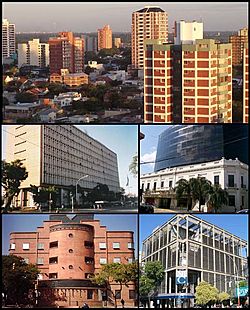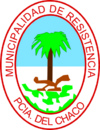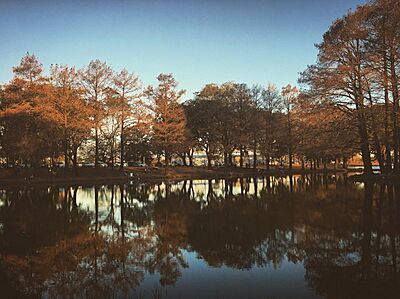Resistencia, Chaco facts for kids
Quick facts for kids
Resistencia
Ciudad de Resistencia
|
|||
|---|---|---|---|

(From top to bottom; from left to right) Panoramic view of the city; Chaco Government House; Palacio de Justicia of Resistencia; Resistencia Casino & Hotel and the New Bank of Chaco.
|
|||
|
|||
| Nickname(s):
City of sculptures
|
|||
| Country | |||
| Province | |||
| Department | San Fernando | ||
| Area | |||
| • City | 562 km2 (217 sq mi) | ||
| Elevation | 20 m (164 ft) | ||
| Population
(2010 census)
|
|||
| • Urban | 291,720 | ||
| Time zone | UTC−3 (ART) | ||
| Area code(s) | +54 362 | ||
| Climate | Cfa | ||
Resistencia (pronounced [resisˈtensja]) is the capital city of Chaco Province in north-eastern Argentina. It is the largest city in the province. In 2010, about 291,720 people lived in the city itself. If you include the nearby towns, the Greater Resistencia area has about 387,340 people. This makes it the biggest city area in Chaco and the eleventh most populated in Argentina. Resistencia is located next to the Negro River, which flows into the much larger Paraná River. It sits across from the city of Corrientes, in Corrientes Province.
Long ago, the area was home to Guaycuru native groups, like the Tobas. These groups strongly resisted outsiders, so European settlement did not happen much until the late 1800s. A proper settlement was finally started in 1865. On January 27, 1878, Resistencia was officially made the capital of the territory. The government encouraged people to move there, and the first Italian immigrants arrived in 1878. The first city council was even made up entirely of people from Italy!
Contents
History of Resistencia
Early Times: Native Peoples and Spanish Explorers
The land where Resistencia is today was originally home to the Guaycuru peoples. These were tribes who moved around on foot, hunting and fishing. One group, the Abipón, lived south of the Bermejo River. They were among the first to move into the central and southern parts of Chaco. The Abipones had three main groups, each with their own way of speaking. Another group, the Payaguá, lived along the Paraguay River. They were known for trading and even some piracy on the Paraná-Paraguay rivers.
Between 1541 and 1580, Spanish explorers traveled all around the Chaco region. In 1588, the city of Corrientes was founded on the other side of the Paraná River.
How Resistencia Was Founded
Resistencia was officially founded on January 27, 1878. This was the day when the first land survey was approved and the colony was formally created.
Many people celebrate February 2 as the day the first immigrants from Friuli, Italy, arrived. However, historical studies show that this was actually the same day the colony was created. The first people came to settle here because of a government plan to populate the region. This plan was based on an immigration law that was popular in Europe at the time. The city grew partly thanks to groups like the Italian Society. This group was started by the first Italians and included many professionals like doctors, architects, and lawyers.
Resistencia in the 20th Century
In 1953, the Chaco region became a province, and Resistencia, which was already the capital, became the provincial capital. In 1939, a new church area called the Diocese of Resistencia was created by Pope Pius XII. Later, in 1984, it became an archdiocese.
In the 1950s, during the time of governors Felipe Gallardo and Deolindo Felipe Bittel, work began on the Resistencia International Airport. Public transportation was also started between Resistencia and Barranqueras. Many new buildings were constructed for schools, police stations, city offices, and health centers.
Geography and Climate
Where is Resistencia Located?
The city is located along the Negro River. This river flows into the much larger Paraná River. Resistencia is directly across the Paraná River from the city of Corrientes, in Corrientes Province.
Understanding Resistencia's Climate
Resistencia is one of the warmest cities in Argentina. It is known for its very hot and humid summers, often with thunderstorms. The climate is called humid subtropical (or Cfa by scientists). This means it has a cooler, drier season and a long, wet summer. Spring and autumn can have quick changes between summer and winter weather.
In summer, temperatures usually reach between 30 and 35 degrees Celsius (86 to 95 degrees Fahrenheit) every day. Sometimes, they can even go up to 38 degrees Celsius (100 degrees Fahrenheit). The hottest temperature ever recorded was 44.4 degrees Celsius (111.9 degrees Fahrenheit) on October 16, 2014. Summer nights are warm and sticky, usually between 19 and 25 degrees Celsius (66 to 77 degrees Fahrenheit). Afternoon thunderstorms are common. The change to autumn is slow. March temperatures are much like midsummer. April is still warm, with an average high of 26.2 degrees Celsius (79.2 degrees Fahrenheit) and a low of 17.0 degrees Celsius (62.6 degrees Fahrenheit). It rains a lot in April, with about 284.9 millimeters (11.22 inches) of rain.
The dry, cool season starts in May and lasts until September. In June and July, which are the coolest months, the average high is 20 degrees Celsius (68 degrees Fahrenheit) and the average low is 10 degrees Celsius (50 degrees Fahrenheit). Rainfall is usually less than 50 millimeters (2 inches) per month. During winter, the weather can change. Sometimes it's warm and dry, like 25 to 30 degrees Celsius (77 to 86 degrees Fahrenheit). Other times, strong winds from the south bring cooler temperatures, around 10 degrees Celsius (50 degrees Fahrenheit), making it feel surprisingly cold. After these cold spells, the air becomes dry, and the skies are clear. Nights can be cold, between 2 and 6 degrees Celsius (36 to 43 degrees Fahrenheit), but days are pleasant and cool, between 15 and 20 degrees Celsius (59 to 68 degrees Fahrenheit). Light frost can happen on very calm, cold nights. The lowest temperature ever recorded was -4.7 degrees Celsius (23.5 degrees Fahrenheit) on June 29, 1996.
| Climate data for Resistencia, Chaco (1991–2020, extremes 1965–present) | |||||||||||||
|---|---|---|---|---|---|---|---|---|---|---|---|---|---|
| Month | Jan | Feb | Mar | Apr | May | Jun | Jul | Aug | Sep | Oct | Nov | Dec | Year |
| Record high °C (°F) | 43.7 (110.7) |
43.5 (110.3) |
41.0 (105.8) |
38.1 (100.6) |
35.5 (95.9) |
34.1 (93.4) |
35.5 (95.9) |
38.0 (100.4) |
43.5 (110.3) |
44.4 (111.9) |
43.5 (110.3) |
42.3 (108.1) |
44.4 (111.9) |
| Mean daily maximum °C (°F) | 33.4 (92.1) |
32.3 (90.1) |
30.7 (87.3) |
27.4 (81.3) |
23.7 (74.7) |
21.7 (71.1) |
21.6 (70.9) |
24.4 (75.9) |
26.2 (79.2) |
28.5 (83.3) |
30.1 (86.2) |
32.2 (90.0) |
27.7 (81.9) |
| Daily mean °C (°F) | 26.9 (80.4) |
26.1 (79.0) |
24.5 (76.1) |
21.4 (70.5) |
17.7 (63.9) |
15.8 (60.4) |
14.8 (58.6) |
16.9 (62.4) |
19.2 (66.6) |
22.2 (72.0) |
23.8 (74.8) |
26.0 (78.8) |
21.3 (70.3) |
| Mean daily minimum °C (°F) | 21.2 (70.2) |
20.8 (69.4) |
19.4 (66.9) |
16.4 (61.5) |
12.8 (55.0) |
11.1 (52.0) |
9.4 (48.9) |
10.7 (51.3) |
12.9 (55.2) |
16.5 (61.7) |
17.7 (63.9) |
20.1 (68.2) |
15.7 (60.3) |
| Record low °C (°F) | 10.6 (51.1) |
9.4 (48.9) |
5.8 (42.4) |
2.1 (35.8) |
−3.2 (26.2) |
−4.7 (23.5) |
−3.8 (25.2) |
−4.1 (24.6) |
−1.4 (29.5) |
1.4 (34.5) |
4.4 (39.9) |
7.7 (45.9) |
−4.7 (23.5) |
| Average precipitation mm (inches) | 179.9 (7.08) |
156.8 (6.17) |
161.0 (6.34) |
165.1 (6.50) |
86.7 (3.41) |
59.9 (2.36) |
24.4 (0.96) |
35.3 (1.39) |
53.6 (2.11) |
138.2 (5.44) |
175.5 (6.91) |
156.7 (6.17) |
1,393.1 (54.85) |
| Average precipitation days (≥ 0.1 mm) | 9.1 | 8.9 | 8.8 | 8.6 | 7.7 | 6.8 | 4.7 | 4.5 | 6.8 | 10.3 | 9.6 | 9.4 | 95.2 |
| Average relative humidity (%) | 71.5 | 74.1 | 76.7 | 80.0 | 82.2 | 81.9 | 76.6 | 70.5 | 68.8 | 71.9 | 71.2 | 71.4 | 74.7 |
| Mean monthly sunshine hours | 235.6 | 206.2 | 186.0 | 171.0 | 158.1 | 126.0 | 151.9 | 170.5 | 156.0 | 182.9 | 228.0 | 229.4 | 2,201.6 |
| Mean daily sunshine hours | 7.6 | 7.3 | 6.0 | 5.7 | 5.1 | 4.2 | 4.9 | 5.5 | 5.2 | 5.9 | 7.6 | 7.4 | 6.0 |
| Source: Servicio Meteorológico Nacional | |||||||||||||
Economy: How Resistencia Makes Money
In the past, Resistencia's economy mainly relied on farming and trade. But in recent years, it has grown to include many different types of services. This means more jobs are in areas like healthcare, education, and tourism.
Culture: The City of Sculptures
Resistencia is famous in Argentina as the "city of sculptures" and an "open-air museum." This is because it has more than 500 sculptures and other artworks placed all over its streets and parks.
Since 1988, the city has hosted a special event called the Resistencia Biennial International Sculptures Contest. After each contest, the new sculptures stay in the city for everyone to see in parks or on sidewalks. Since 1997, this event has been supported by UNESCO, a part of the United Nations. Resistencia also has several museums, including:
- The René Bruseau Provincial Museum of Fine Arts (for art)
- The Augusto Schulz Museum of Natural History (for nature)
- The Juan Alfredo Martinet Museum of Anthropology (for human history and culture)
- The Ichoalay Cultural Museum
- The Ertivio Acosta Museum of Man in Chaco
Transportation in Resistencia
Resistencia has its own airport, the Resistencia International Airport, which opened in 1965. The airport building, finished in 1971, was designed by a famous architect named Amancio Williams.
You can reach Resistencia by major roads:
- National Route 11 runs from north to south.
- National Route 16 goes west.
- The General Belgrano Bridge connects Resistencia to its nearby city, Corrientes. This bridge opened in 1973.
Train services in the area stopped in the early 1990s when many railways were privatized. However, train links were brought back in 1997 with the Sefecha line, which was funded by the province.

Sister Cities Around the World
Resistencia has special connections with other cities around the world. These are called "sister cities" or "twin towns." They often share cultural or historical ties.
 Udine, Italy (since 1978)
Udine, Italy (since 1978) Trento, Italy
Trento, Italy Asunción, Paraguay (since 2006)
Asunción, Paraguay (since 2006) Tarija, Bolivia
Tarija, Bolivia São Vicente, Brazil (since 2006)
São Vicente, Brazil (since 2006)
Famous People from Resistencia
Many notable individuals have come from Resistencia:
- Emilio Ambasz, an architect
- Miguel Ángel Carbonell, a footballer
- Elisa Carrió, a politician
- Emiliano Grillo, a professional golfer
- Matías Martínez, a footballer
- Juan Manuel Silva, a racing driver
- Etel Solingen, a political scientist
See also
 In Spanish: Resistencia (ciudad) para niños
In Spanish: Resistencia (ciudad) para niños






